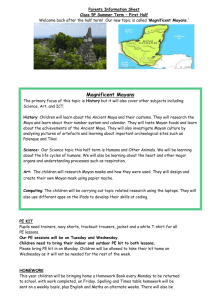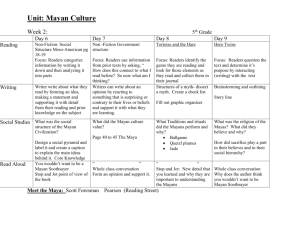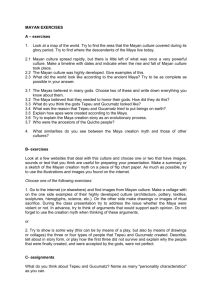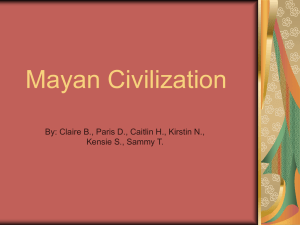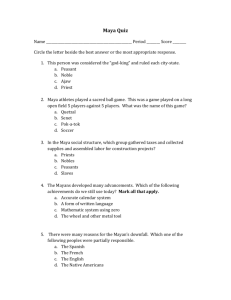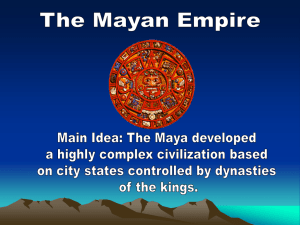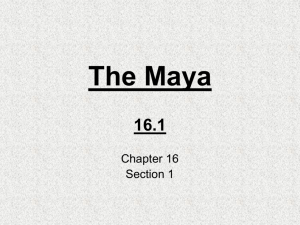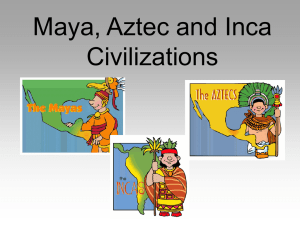Your Task
advertisement
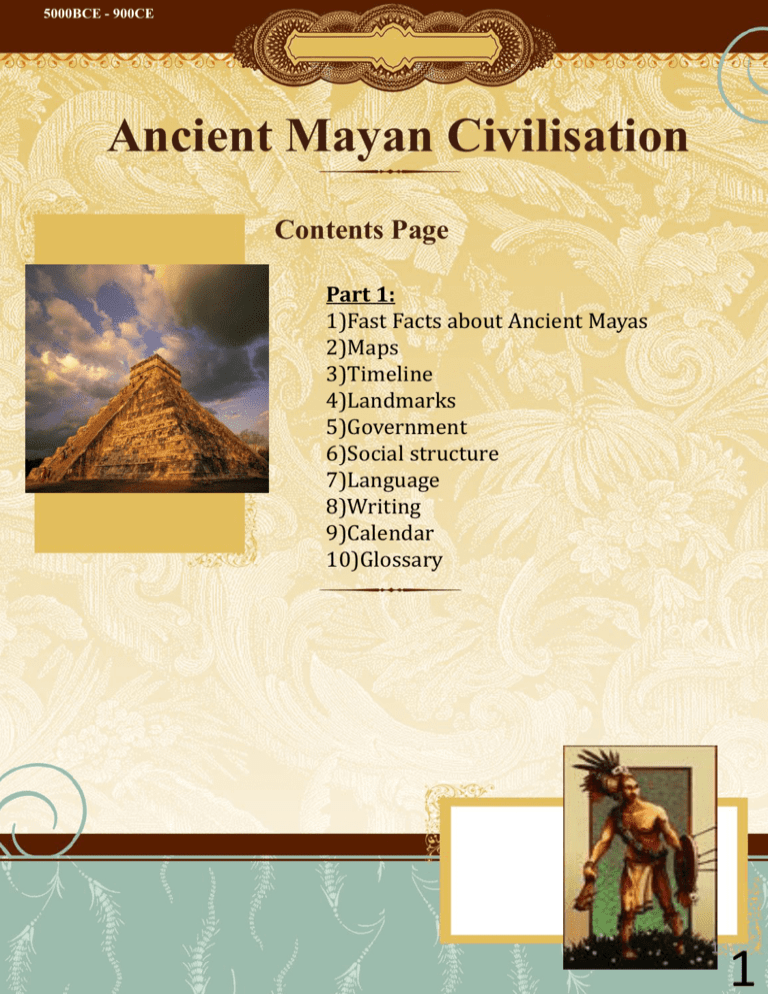
5000BCE - 900CE Ancient Mayan Civilisation Contents Page Part 1: 1)Fast Facts about Ancient Mayas 2)Maps 3)Timeline 4)Landmarks 5)Government 6)Social structure 7)Language 8)Writing 9)Calendar 10)Glossary 1 1 Oct 2001 BC VOL.87# ONE ISSUE #90 Fast Facts: Deep within the jungles of Mexico and Guatemala and as far as the Yucatan peninsula lie the mysterious temples and Mayan pyramids. While Europe was still in the middle of the Dark Ages, these amazing people had mapped the heavens, evolved the only true writing system native to the Americas and were masters of mathematics The Maya are probably the bestknown Ancient civilisation of Mesoamerica. Originating in the Yucatan around 2600 B.C., they rose to prominence around A.D. 250 in present-day southern Mexico, Guatemala, northern Belize and western Honduras. Building on the inherited inventions and ideas of earlier civilizations such as the Olmec, the Maya developed astronomy, calendrical systems, chocolate, ancient basketball and hieroglyphic writing. Little is known by traditional researchers about the pyramids of Teotihuacan (pronounced tay-oh-teewah-con, and simply referred to as "Teo" by the locals). (Photo displayed above) The Mayan pyramids of Teotihuacan rise as high as twenty-story buildings, above the central Mexican highlands with a grandeur and mystery that stirs the imagination and inspires the soul. Mayas lived in low-lying rainforests. The land was mostly marshy and swampy with threes growing very high to reach the sunlight. The climate was hot and humid and it was hard to travel fast or far because of the thick jungle. Your Task: Create a KWL chart in your book: 1. 2. 3. What do you know about the Mayas? What do you want to know? What have you learnt? (we’ll fill this one in at the end of the unit) What do you know? What do you want to know? What have you learnt? 2 Where in the world did the Mayas live? Your Task:. Using Google Earth and any other sources necessary online, label on a world ma where the Mayas lived and paste it into your Humanities book. Your map must include BOLTSS (Border, Orientation, Legend, Title, Scale, and Source) and also the coordinates of where to find the Mayas society. Extension Task: Compare Ancient ‘Mesoamerica’s’ map (pictured below) to a modern day map of ‘Central America’. Create a Venn diagram listing the similarities and differences between the two maps, focusing on names of the regions and any other interesting facts you observe. 3 Maya Timeline Using the following interactive online resource: https://webspace.utexas.edu/jgk1102/maya_map_timeline.html, create your own timeline of what you believe to be the most significant events throughout the Ancient Mayan History. 4 Ancient Maya Landmarks Pyramid, Temples, Ball Courts and Lost Cities The Mayans, considered one of the most advanced ancient civilizations, primarily lived near the Yucatan areas of Mexico and Mesoamerica (Central America). Their extensive cities were developed with palaces, temples and ball courts. You can visit ancient Mayan landmarks at ruin sites in Mexico, Belize, Honduras and Guatemala. The Mayan version of the pyramid was constructed so that a temple could be built on the top. The ancient Mayans built two types of pyramids, those that were meant to be climbed and those that were not. The first type was used for holding sacrificial rituals. The other type was not meant to be touched and was sacred. Mexica: •Uxmal (Home to ceremonial sites) •Cichen Itza (Warriors’ Temple) •Palenqye (Mayan Sanctuary) Honduras: •Copan (Tunnels, ball courts, Acropolis) Guatemala: •Kaminal Juyu (Sculptures, Architecture, Tikal) • Tikal (Great Pyramid with two headed snake) •Cancuen (The lost city) Belize: •Caracol ( Tallest man made structure in Belize) •Altun Ha (Trading centre) •Lubaantun (Cerimonial Centre) Your Task: Answer the questions below in full sentences in your book: 1. Name 3 types of building the Ancient Mayans included in their towns. 2. What was on top of the Mayan pyramids? 3. What were the different types of pyramids the Mayans built? 4. How many of each type of pyramid are listed in the text? Extension Task 1. 2. 3. Why do you think both the Maya and Egyptian civilisations built pyramids? Why did they take such time and care in constructing them? Write 3-4 sentences in your book explaining your opinion. 5 Government One noble family controlled each city. When the ruling noble died, his job passed to his son. No one else got a shot at it. The noble families’ right to rule originated with the Hero Twins. It was believed that each noble family was ‘supposedly’ related to one of the Hero Twins. That gave them a good enough reason to keep their job. They were directly related to the gods. The ruling noble did not do his job alone. Part of his job was to select a council of elders and warriors to help him rule. Other people were also selected to help run the government. Some people were chosen to enforce laws. Others were chosen to act as judges. So the Mayas ruled themselves via a system of citystates. Maya priests were also the rulers of cities. Every day they would perform services after climbing the hundreds of temple steps. Maya priests might have caused the collapse of the Maya when the lesser Mayas (farmers) got tired of having to obey the commands of the priests and abandoned the cities. Fast Fact: One of the most famous Maya rulers was Lord Pacal. He became a king at the age of 6 and legally took the throne at 12. Pacal was a priest, ruler and king for about 50 years before he died. When his tomb was discovered he was wearing a jade death mask. Your Task: Read the information to the right about Mayan governments and then answer the questions below in full sentences in your book: 1. Who ruled the Mayan people? 2. Was there only one ruler? If not, how many? 3. How was the leader of the Mayan civilization chosen? 4. Who else helped the noble rule each city? Extension Task: Using a table in your book, compare the Ancient Mayas government to our government in Australia. What do we have in common? What are the main differences? Which is better in your opinion? Who are the Hero Twins? Like all people everywhere, the Mayas loved stories. One of their favorite stories was The Legend of the Hero Twins. Find out soon!!! 6 Mayan Social Structure Not surprisingly the Mayan social structure was shaped like a pyramid. Much like other civilisations of the ancient world, the Mayans depended on their social classes to keep order and structure within their society. The people at the bottom of the Mayan social ladder were the farmers and slaves. These two groups made up the base of the power pyramid of the Mayas. Most people in Mayan civilisation were farmers, but their rights in society were not much better than those of slaves. Slaves were usually captured enemies or criminals. The farmers and slaves performed most of the hard labour and Of course, the farmers provided the entire society with its most important resource - food. They likely made up a bulk of the Mayan military as well. The middle class within Mayan society was made up of professionals, bureaucrats (government workers), artisans, and merchants. They had a lot more wealth than the lower classes, and they were to be respected by the farmers and slaves as well. The middle class also served an important function in Mayan society; they provided a source of goods and services (other than food and labour) that could be exchanged in trade. They were also expected to supply some amount of free labour to the upper class, and they tended to make up the middle ranks in the Mayan military. The smallest (and most wealthy and powerful) layer of Mayan social structure was the ruling noble class. The head of this class and of all the citisens in each Mayan city was the king. He was flanked by his priests and nobles. This structure worked because the lower and middle classes believed that the upper class had been granted the right to rule by the gods. In fact, they probably believed that the nobles were somehow descendant from the gods. Women probably were members of all three social classes depending on their family position and/or by marriage. Your Task: Draw a Mayan power pyramid in your book, listing which people belonged to each level. Then answer the questions below in full sentence: 1. 2. 3. What level of the ‘power pyramid’ were the professionals on? Who made up the biggest part of the military? Where did women fit on the ‘power pyramid’? Extension Task: Schools have a similar system to the Mayas in terms of power. At what levels would you place assistant principal, students, teachers, principal and teaching aids? 1. Draw a pyramid in your books of your school’s power structure and label where each of the people involved belong. 7 How did the Mayans’ Communicate? The two Mayan languages of the Classic period were Yucatecan and Cholan which have been divided into about thirty separate local languages. For some of these languages, there has not been enough written versions found to be able to translate or understand what they were like. The most widely spoken were Mam, Quiché, Kekchí, and Cakchiquel. A lot of people are angry at the fact that the Indigenous languages have been lost over time. Native Americans also get very upset at the fact that the main language spoken in Mexico’s government, education, the media and church these days is Spanish. Your Task: Write your answers in full sentences in your book. 1. How many separate languages were there in Mayan times? Why so many? 2. Why don’t we know a lot about all of these language? 3. Why is Spanish the most common language spoken in Mexico today? 4. Why would some people be angry at this? Extension Task: Can you think of other countries that have lost their native languages when another nations invaded them? 1. List as many countries as you can think of that were invaded by another nation, who invaded them, and what language they speak today. Create an excel spread-sheet. Country Invaded by Language today 8 Writing The earliest known writing by the Mayan Dates from about 250 BCE, but the writing is thought to have developed at an earlier date. The Mayans used a combination of phonetic symbols (pictures that sound like the word), numbers and ideograms or glyphs (pictures). The deciphering of the Maya writings has been a long process. Bits of it were first deciphered in the late 19th and early 20th century (mostly the parts having to do with numbers, the calendar, and astronomy), but major breakthroughs came starting in the 1960s and 1970s so that now the majority of Maya texts can be read nearly completely in their original languages. With the decipherment of the Maya script it was discovered that the Maya were one of the few civilizations where artists attached their name to their work. Their writing was highly sophisticated. Most likely only members of the higher classes were able to read their symbols. Maya writing was composed of recorded inscriptions on stone and wood and used within architecture. Rectangular lumps of plaster and paint chips are a frequent discovery in Maya archaeology; they are the remains of what had been books after all the organic material has decayed. Folding tree books were made from fig tree bark and placed in royal tombs. Unfortunately, many of these books did not survive the humidity of the tropics or the invasion of the Spanish, who regarded the symbolic writing as the work of the devil. The Maya also carved these symbols into stone, but the most common place for writing was probably the highly perishable books they made from bark paper, coated with lime to make a fresh white surface. These 'books' were screen-folded and bound with wood and deer hide. They are called codices. Unfortunately zealous Spanish priests shortly after the conquest ordered the burning of all the Maya books. While many stone inscriptions survive - mostly from cities already abandoned when the Spanish arrived - only 3 books and a few pages of a fourth survive from the ancient libraries. Only four codices remain today. 9 Your Task: Read the information about Mayan writing and answer the questions below in full sentences in your book: 1. 2. 3. 4. 5. 6. What are the 3 different things Mayans used in their writing? Who was able to read the codices? What were their books made of? What happened to all the codices? How many codices are left today? Why did the Spanish priests destroy the codices? Your Task: Create-Your-Own Codex MAYA FACT: The Maya recorded important information — such as scientific discoveries and historical records — using glyphs, or pictures, instead of an alphabet. Glyphs were painted on pottery, inscribed into fig-bark books called codices, and carved into stone. ACTIVITY: Use publisher to create your very own codices to record an important event in your life. For each codex, use half of a piece of coloured paper, folded into three to create three surfaces. Next, draw an original glyph on each surface with coloured pencils. On the back of your coloured paper you can describe what your codex is saying. Extension Task: Create a codex of an important event in Mayas history, such as the building of Teotihuacan or a blood sacrifice on top of a temple. Use a combination of glyphs, numbers and symbols to tell the story. 10 Will The World End in 2012? Mayan Calendar Your Task: The Mayans developed three different calendars. Choose ONE calendar from the list below and use books and the Internet to learn more about it. Present your information in digital form and email it to your teacher. You should find out: 1. What it looked like and what information it contained (include a picture of your calendar). 2. How your calendar was created. 3. What the Ancient Mayas used the calendar for. 4. Did they use this calendar to make any predictions? 5. What were these predictions? Have they come true? Calendars to choose from: Tzolk’in calendar Haab calendar Long count calendar Extension Task: Compare the Mayan calendar you researched to the one we use today. 1. What are the similarities and differences? 2. Why do you think it has changed? 3. Show your answers in a chart like the one below: Mayan Calender Features Our Modern Calendar Features Similarities Differences Glossary ureaucrats: (Government, Politics & Diplomacy) an official in a bureaucracy odices: code, from Latin codex, meaning "block of wood split into tablets, documen written on wood tablets," was first a set of laws ity-state: a sovereign state consisting of an independent city and its surroundin erritory lders: an older, influential member of a family, tribe, or community volved: to gradually develop randeur: the quality or condition of being grand; magnificence uatemala: A country of northern Mesoamerica, or what is know known as Centra merica ndigenous: originating and living or occurring naturally in an area or environment nherited: to receive (property or a title, for example) from an ancestor by lega uccession or will Mesoamerica: a region extending south and east from central Mexico to include part f Guatemala, Belize, Honduras, and Nicaragua Mexico: a country of south-central North America ative: originating, growing, or produced in a certain place or region lmec: An early Mesoamerican Indian civilization centred in the Veracruz region o outheast Mexico that flourished between 1300 and 400 B.C., whose cultural influenc was widespread throughout southern Mexico and Central America ociety: a group of humans broadly distinguished from other groups by mutua nterests, participation in characteristic relationships, shared institutions, and ommon culture talemate: A situation in which further action is blocked or stopped upposedly: presumed to be true or real without conclusive evidence eotihuacan: an ancient city of central Mexico northeast of present-day Mexico Cit s ruins include the Pyramid of the Sun and the Temple of Quetzalcoat ucatan: a state of Mexico on the northern part of the Yucatan Peninsula 12
